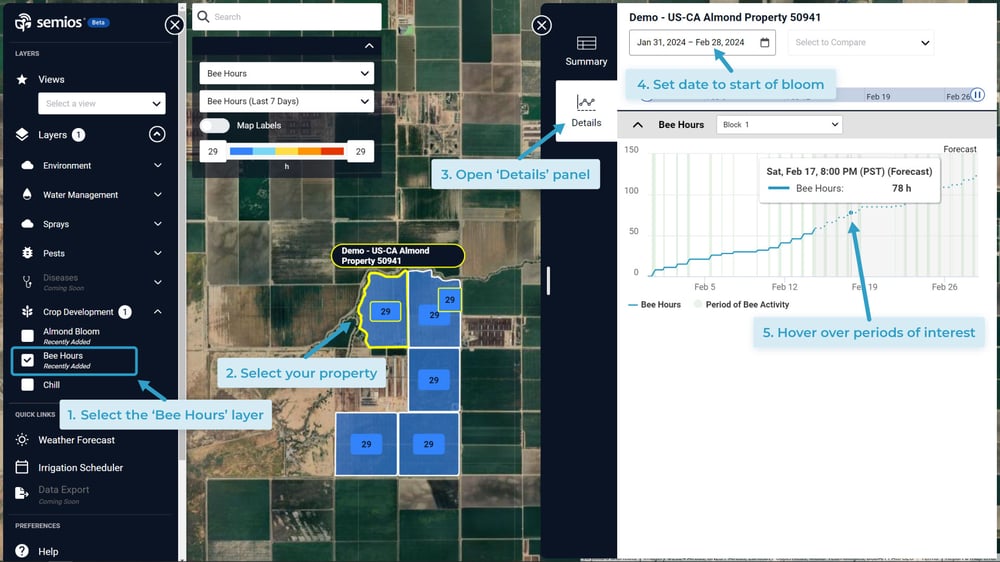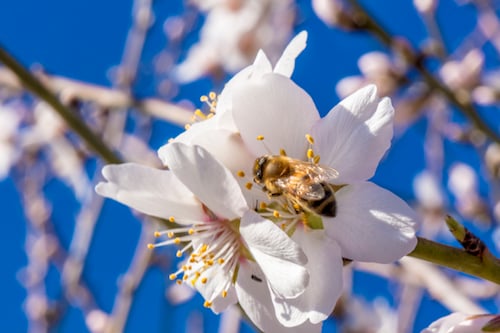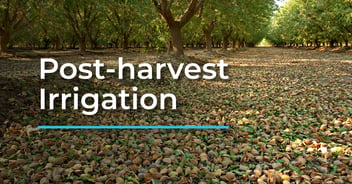Bee hours are an important metric for growers to track almond tree pollination to know when to take action to extend the bloom period, when to time bloom sprays, and to help troubleshoot years with poor fruit or nut set.
Find out how California's Central Valley bee hours are accumulating compared to last season and see your forecasted bee hours for the rest of the almond pollination season.
Semios' California Bee Hours Dashboard

See how bee hours are progressing across North, Mid, and South Valley with our free regional dashboard that's updated every 12 hours. You can use it to track:
- how bee hour accumulation compare this year vs. last season
- forecasted cumulative bee hours
- daily bee activity start and end times by region
Fill out the form below to get access:
See your site-specific bee hours on Semios
Bee hours that are accumulated during the bloom overlap period should be used to assess pollination during bloom.
Semios users can view their historical and forecasted site-specific bee hours on the Semios platform for the most accurate data:

How to view your bee hours graph:
- Under the 'Layers' menu, open the 'Crop Development' dropdown, and select the 'Bee Hours' layer
- Select your property on the map.
- Open the 'Details' panel.
- Set the date at the top to the start of bloom.
- Hover over periods of interest on the bee hours graph.
💡 Tip: Want to know how your bee hours are progressing compared to a previous season? Click the 'Select to Compare' dropdown beside the data selector, and choose your season of interest from the list.
Understanding bee hours
Bee hours tell you the hours in which conditions are favorable for bees to fly.
A bee hour is defined as one hour where:
- There is no rain
- The temperature is warmer than 55° F, and
- Wind speeds are less than 15 mph
More bee activity means more opportunities for pollination, making bee hours a valuable metric for getting a sense of how fruit or nut set, and ultimately yield, may compare between years.

Three ways to use bee hours
1. Adjusting the bloom period
In crops that require cross-pollination such as almonds, bee hours are only effective when bloom between different varieties overlap.
A shorter bloom overlap can mean a shorter period where bee hours can accumulate. In years where bee hours are high, this may not be an issue, but in years where bee hours are low, you may want to consider taking action to extend the bloom period.
2. Plan your bloom-time sprays
Chemical applications should be avoided when bees are active in the orchard. Limiting spray applications to the late afternoon and evenings is recommended to target periods when bees are inactive. An extra level of assurance can be achieved by only spraying when bee hours are not expected to accumulate.
💡 Semios customers can use their Pollination Dashboard to view their orchard’s forecasted bee active hours and plan sprays when bees aren’t present.
3. Troubleshooting poor fruit or nut set
After the bloom season, bee hours can help you troubleshoot what went right and wrong. If you had more bee hours this season but a poor fruit set compared to a previous year with fewer bee hours, there may be something else that may be going on in your orchard.
This article is for informational purposes only. Please consult your PCA or Crop Advisor for advice.
Additional Resources
Honey Bee Best Management Practices


.jpg?width=352&name=_MG_6932%20(2).jpg)

